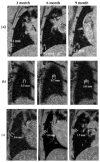A gated-7T MRI technique for tracking lung tumor development and progression in mice after exposure to low doses of ionizing radiation
- PMID: 22950352
- PMCID: PMC3478889
- DOI: 10.1667/rr2800.1
A gated-7T MRI technique for tracking lung tumor development and progression in mice after exposure to low doses of ionizing radiation
Abstract
A gated-7T magnetic resonance imaging (MRI) application is described that can accurately and efficiently measure the size of in vivo mouse lung tumors from ∼0.1 mm(3) to >4 mm(3). This MRI approach fills a void in radiation research because the technique can be used to noninvasively measure the growth rate of lung tumors in large numbers of mice that have been irradiated with low doses (<50 mGy) without the additional radiation exposure associated with planar X ray, CT or PET imaging. High quality, high resolution, reproducible images of the mouse thorax were obtained in ∼20 min using: (1) a Bruker 7T micro-MRI scanner equipped with a 60 mm inner diameter gradient insert capable of generating a maximum gradient of 1000 mT/m; (2) a 35 mm inner diameter quadrature radiofrequency volume coil; and (3) an electrocardiogram and respiratory gated Fast Low Angle Shot (FLASH) pulse sequence. The images had an in-plane image resolution of 98 μm and a 0.5 mm slice thickness. Tumor diameter measured by MRI was highly correlated (R(2) = 0.97) with the tumor diameter measured by electronic calipers. Data generated with an initiation/promotion mouse model of lung carcinogenesis and this MRI technique demonstrated that mice exposed to 4 weekly fractions of 10, 30 or 50 mGy of CT radiation had the same lung tumor growth rate as that measured in sham-irradiated mice. In summary, this high-field, double-gated MRI approach is an efficient way of quantitatively tracking lung tumor development and progression after exposure to low doses of ionizing radiation.
Figures




Similar articles
-
In vivo MRI for effective non-invasive detection and follow-up of an orthotopic mouse model of lung cancer.NMR Biomed. 2014 Aug;27(8):971-9. doi: 10.1002/nbm.3142. Epub 2014 Jun 10. NMR Biomed. 2014. PMID: 24913958
-
Echo-planar imaging for MRI evaluation of intrathoracic tumors in murine models of lung cancer.J Magn Reson Imaging. 2008 Jan;27(1):57-62. doi: 10.1002/jmri.21221. J Magn Reson Imaging. 2008. PMID: 18058933
-
Cancer-prone mice expressing the Ki-rasG12C gene show increased lung carcinogenesis after CT screening exposures.Radiat Res. 2011 Dec;176(6):842-8. doi: 10.1667/rr2649.1. Epub 2011 Sep 30. Radiat Res. 2011. PMID: 21962004 Free PMC article.
-
A modern view on the effect of ionizing radiation on patients with diagnosis of nuclei cell cancer and its dischariationn.Probl Radiac Med Radiobiol. 2017 Dec;22:69-78. Probl Radiac Med Radiobiol. 2017. PMID: 29286497 Review. English, Ukrainian.
-
Use of Magnetic Resonance Imaging in Food Quality Control: A Review.J Biomed Phys Eng. 2018 Mar 1;8(1):127-132. eCollection 2018 Mar. J Biomed Phys Eng. 2018. PMID: 29732347 Free PMC article. Review.
Cited by
-
A rapid micro-magnetic resonance imaging scanning for three-dimensional reconstruction of peripheral nerve fascicles.Neural Regen Res. 2018 Nov;13(11):1953-1960. doi: 10.4103/1673-5374.238718. Neural Regen Res. 2018. PMID: 30233069 Free PMC article.
-
Total-body irradiation produces late degenerative joint damage in rats.Int J Radiat Biol. 2014 Sep;90(9):821-30. doi: 10.3109/09553002.2014.927935. Epub 2014 Aug 11. Int J Radiat Biol. 2014. PMID: 24885745 Free PMC article.
-
Cardio-Respiratory synchronized bSSFP MRI for high throughput in vivo lung tumour quantification.PLoS One. 2019 Feb 12;14(2):e0212172. doi: 10.1371/journal.pone.0212172. eCollection 2019. PLoS One. 2019. PMID: 30753240 Free PMC article.
-
OBSERVE: guidelines for the refinement of rodent cancer models.Nat Protoc. 2024 Sep;19(9):2571-2596. doi: 10.1038/s41596-024-00998-w. Epub 2024 Jul 11. Nat Protoc. 2024. PMID: 38992214 Review.
-
Differentiating lung cancer and infection based on measurements of extracellular pH with acidoCEST MRI.Sci Rep. 2019 Sep 10;9(1):13002. doi: 10.1038/s41598-019-49514-1. Sci Rep. 2019. PMID: 31506562 Free PMC article.
References
-
- Division of Cancer Prevention and Control, National Center for Chronic Disease Prevention and Health Promotion. Centers for Disease Control and Prevention. ( http://www.cdc.gov/cancer/lung/statistics/index.htm) [Page last updated: November 23, 2010, cited: September 7, 2011]
-
- Jemal A, Siegel R, Xu J, Ward E. Cancer statistics, 2010. Cancer J Clin. 2010;60:277–300. - PubMed
-
- Pawaroo D, Cummings NM, Musonda P, Rintoul RC, Rassl D, Beadsmoore C. Non-small cell lung carcinoma: accuracy of PET/CT in determining the size of T1 and T2 primary tumors. AJR Am J Roentgenol. 2011;196:1176–81. - PubMed
-
- Fischer B, Lassen U, Mortensen J, Larsen S, Loft A, Bertelsen A, et al. Preoperative staging of lung cancer with combined PET-CT. N Engl J Med. 2009;361(1):32–9. - PubMed
Publication types
MeSH terms
Grants and funding
LinkOut - more resources
Full Text Sources
Medical

